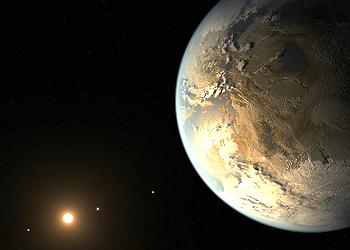
WASHINGTON, DC, April 17, 2014 (ENS) – Using NASA’s Kepler Space Telescope, astronomers have discovered the first Earth-size planet orbiting a star in the “habitable zone,” advancing the search for life as we know it elsewhere in the universe.
The habitable zone is the range of distance from a star where liquid water might pool on the surface of an orbiting planet.

NASA has named the planet Kepler-186f because it is located in the Kepler-186 system, about 500 light-years from Earth in the constellation Cygnus.
It orbits a star about half the size and mass of our sun that is classed as an M dwarf, or red dwarf. This class of stars makes up 70 percent of the stars in the Milky Way galaxy.
Four companion planets also orbit the same red dwarf sun. These companion planets – Kepler-186b, Kepler-186c, Kepler-186d, and Kepler-186e – zoom around their sun every four, seven, 13, and 22 days, respectively, making them too hot for life as we know it. These four inner planets all measure less than 1.5 times the size of Earth.
“The discovery of Kepler-186f is a significant step toward finding worlds like our planet Earth,” said Paul Hertz, NASA’s Astrophysics Division director at the agency’s headquarters in Washington.
While the size of Kepler-186f is known, its mass and composition are not, but previous research suggests that a planet the size of Kepler-186f is likely to be rocky.
“Future NASA missions, like the Transiting Exoplanet Survey Satellite and the James Webb Space Telescope, will discover the nearest rocky exoplanets and determine their composition and atmospheric conditions, continuing humankind’s quest to find truly Earth-like worlds,” said Hertz.
The discovery of Kepler-186f confirms that planets the size of Earth exist in the habitable zone of stars other than our sun. In the habitable zone, the surface temperature of an orbiting planet might sustain liquid water.
While planets have been found in the habitable zone before this, they are all at least 40 percent larger in size than Earth and NASA says understanding their makeup is challenging.
Kepler-186f is more like Earth.
“We know of just one planet where life exists – Earth. When we search for life outside our solar system we focus on finding planets with characteristics that mimic that of Earth,” said Elisa Quintana, research scientist at the SETI Institute at NASA’s Ames Research Center in Moffett Field, California, and lead author of the paper published today in the journal “Science.”
“Finding a habitable zone planet comparable to Earth in size is a major step forward,” said Quintana.
“M dwarfs are the most numerous stars,” she said. “The first signs of other life in the galaxy may well come from planets orbiting an M dwarf.”
Kepler-186f orbits its star once every 130 days and receives one-third the energy from its star that Earth gets from the sun, placing it near the outer edge of the habitable zone.
On the surface of Kepler-186f, the brightness of its star at high noon is only as bright as our sun appears to us about an hour before sunset, NASA scientists say.
“Being in the habitable zone does not mean we know this planet is habitable. The temperature on the planet is strongly dependent on what kind of atmosphere the planet has,” said Thomas Barclay, research scientist at the Bay Area Environmental Research Institute at Ames, and co-author of the paper.
“Kepler-186f can be thought of as an Earth-cousin rather than an Earth-twin,” said Barclay. “It has many properties that resemble Earth.”
The next steps in the search for distant life include looking for true Earth-twins – Earth-size planets orbiting within the habitable zone of a sun-like star – and measuring the their chemical compositions.

Launched in March 2009, the Kepler Space Telescope, which simultaneously and continuously measures the brightness of more than 150,000 stars, is NASA’s first mission capable of detecting Earth-size planets around stars like our sun.
The telescope has since detected planets and planet candidates spanning a wide range of sizes and orbital distances, including those in the habitable zone. These findings have led to a better understanding of our place in the galaxy.
Ames is responsible for Kepler’s ground system development, mission operations, and science data analysis.
NASA’s Jet Propulsion Laboratory in Pasadena, California, managed Kepler mission development.
Ball Aerospace & Technologies Corp. in Boulder, Colo., developed the Kepler flight system and supports mission operations with the Laboratory for Atmospheric and Space Physics at the University of Colorado in Boulder.
The Space Telescope Science Institute in Baltimore archives, hosts and distributes Kepler science data.
Kepler is NASA’s 10th Discovery Mission and was funded by the agency’s Science Mission Directorate.
The SETI Institute is a private, nonprofit organization dedicated to scientific research, education and public outreach. The mission of the SETI Institute is to explore, understand and explain the origin, nature and prevalence of life in the universe.
Copyright Environment News Service (ENS) 2014. All rights reserved.
